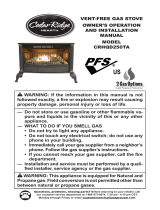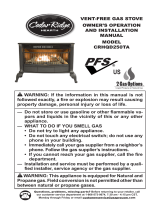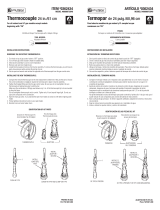
www.usaprocom.com
200124-01B16
OPERATION
FOR YOUR SAFETY READ BEFORE LIGHTING
WARNING: If you do not fol-
low these instructions exactly, a
re or explosion may result caus-
ing property damage, personal
injury or loss of life.
A. This appliance has a pilot which must
be lighted by hand. When lighting the
pilot, follow these instructions exactly.
B. BEFORE LIGHTING smell all around
the appliance area for gas. Be sure to
smell next to the oor because some
gas is heavier than air and will settle
on the oor.
WHAT TO DO IF YOU SMELL GAS
• Do not try to light any appliance.
• Do not touch any electric switch; do
not use any phone in your building.
• Immediately call your gas supplier
from a neighbor’s phone. Follow the
gas supplier’s instructions.
• If you cannot reach your gas supplier,
call the re department.
C. Use only your hand to push in or turn
the gas control knob. Never use tools.
If the knob will not push in or turn
by hand, don’t try to repair it, call a
qualied service technician. Force or
attempted repair may result in a re or
explosion.
D. Do not use this appliance if any part
has been under water. Immediately call
a qualied service technician to inspect
the appliance and to replace any part of
the control system and any gas control
which has been under water.
WARNING: You must oper-
ate this heater with the screen
in place. Make sure screen is
installed before running heater.
NOTICE: During initial operation of
new heater, burning logs will give
off a paper-burning smell. Orange
ame will also be present. Open
damper or window to vent smell.
This will only last a few hours.
1. STOP! Read the safety information above.
2. Make sure equipment shutoff valve is fully
open.
3. Turn control knob clockwise to the
OFF position.
4. Wait ve (5) minutes to clear out any gas.
Then smell for gas around heater and near
the oor. If you smell gas, STOP! Follow
"B" in the safety information above. If you
do not smell gas, go to the next step.
5. Turn control knob counterclockwise
to the PILOT position. Press in control
knob for ve (5) seconds.
Note: The rst time that the heater is oper-
ated after connecting the gas supply, the
control knob should be pressed for about
thirty (30) seconds. This will allow air to
bleed from the gas system. If pilot does not
stay lit, refer to Troubleshooting, pages 21
though 23. Also contact a qualied service
technician or gas supplier for repairs. Until
repairs are made, light pilot with match.
• If control knob does not pop up when
released, contact a qualified service
technician or gas supplier for repairs.
6. With control knob pressed in, push
down and release ignitor button. This
will light pilot. The pilot is attached to
the rear of the burner. If needed, keep
pressing ignitor button until pilot lights.
LIGHTING INSTRUCTIONS
Ignitor Button
Control Knob
Figure 17 - Ignitor Button and Control
Knob Locations






























